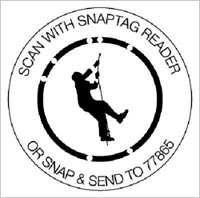 Readers of former Kodak CMO Jeffrey Hayzlett’s upcoming business book Running the Gauntlet will get videos of the marketing guru to start
every chapter, courtesy of 2D mobile codes.
Readers of former Kodak CMO Jeffrey Hayzlett’s upcoming business book Running the Gauntlet will get videos of the marketing guru to start
every chapter, courtesy of 2D mobile codes.
The typical biz book of 10 chapters was too traditional for a project that purports to help readers “drive change” in their own
companies. The author, speaker and consultant decided to structure his second book differently from the usual business guide. "We decided to be more interactive -- 35 chapters of about 1,500 words
each,” he says. Each chapter would get a 2D code that triggered an introductory video of Hayzlett introducing or enhancing the topic.
This is one of the first and more extensive uses
of mobile codes in a full-length book. Joseph Mitchell’s The Zappos Experience was published several months ago with embedded codes, and Publishers Weekly reports a
number of projects coming soon that will be deploying the familiar and generally unsightly two-toned QR codes.
advertisement
advertisement
That was Hayzlett’s original plan, although he considers QR encoding
“ugly codes. The book had already been laid out to include QR embeds when he saw SnapTag’s CEO Nicole Skogg at a conference show her company’s alternative 2D code, which uses
custom art that can include logos and branding.
Now users of Running theGauntlet -- scheduled for release Jan. 3 -- can snap an image of the relevant chapter SnapTag
and send it either by email, MMS or via a dedicated reader app to the vendor and be linked to the video.
The video clips run 30 seconds to a minute. Hayzlett says video enhancements to a
book like his are an added value; people retain information more readily from multimedia formats while making the experience more personal. “You can convey things on video, and it is a
reflection of me and a more interactive touchpoint with the book,” he says.
One of the unique advantages of adding 2D codes is the feedback loop of user data it provides. Skogg
says that for the first time, authors will have some rough gauge of reader engagement. “We will be able to measure engagement from how many tags a user scans and their frequency. We can look
at a time line and see if they are jumping around in the book -- did they read it in a week, or are they keeping it with them for six months?”
While not a precise measure of where and
for how long a reader is paying attention in a book, Hayzlett admits, analyzing code activations can give a sense of which topics proved more and less interesting to the reader and which they
reference again.
Hayzlett, a marketer at heart, believes that over time mobile codes in books can be leveraged to cultivate closer relationships with readers. “We can offer them
special offers or have them 'friend me'" -- and make the reader feel in closer touch with the author.